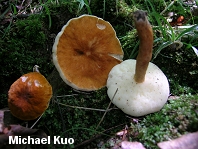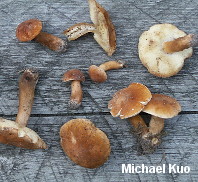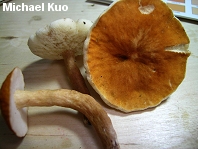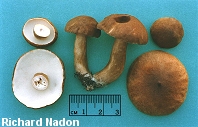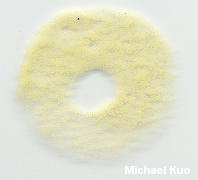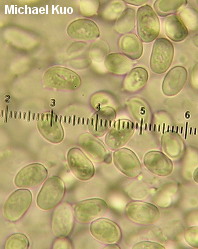| Major Groups > Boletes > Gyroporus > Gyroporus castaneus |

|
Gyroporus castaneus [ Basidiomycota > Boletales > Gyroporaceae > Gyroporus . . . ] by Michael Kuo This little bolete is a common summer feature in eastern North America's hardwood forests, easily recognized by its hollowing stem, relatively small size, the often splitting cap margin, and its pale yellow spore print. Gyroporus castaneus is chestnut brown, while a closely related and similar species, Gyroporus purpurinus, is purplish red. Although I find Gyroporus castaneus in hardwood forests, I also often find it along grassy road banks, on trails, and in woodland waste areas, growing alone or scattered near potential mycorrhizal hosts . . . or sometimes not so near them. This makes me wonder whether the mushroom is truly mycorrhizal--a wonder shared by bolete guru Ernst Both (1993), who writes that Gyroporus castaneus is "apparently not mycorrhizal" but does not, unfortunately, expand on the point. At the very least, it seems, the species appears to have an affinity for recently disturbed ground. Although North American bolete literature almost universally reports spore dimensions for Gyroporus castaneus as approximately 8-13 x 5-6 µ, my collections from Pennsylvania, Illinois, and Minnesota all have much smaller spores, measuring 6-8 x 4-5 µ. Ortiz-Santana and collaborators (2007) document a similarly small-spored collection from Belize; this is the only other record I find that corresponds to my collections. Description: Ecology: Usually reported as mycorrhizal with oaks and other hardwoods (and sometimes reported under conifers)--but possibly saprobic, or merely facultatively mycorrhizal (see comments above); growing alone, scattered, or gregariously; summer and fall; widely distributed and common in eastern North America, but rare to absent in most western areas. Trudell & Ammirati (2009) report Gyroporus castaneus in urban areas of the Pacific Northwest, probably imported with landscape trees. Cap: 2-10 cm; convex, becoming broadly convex or nearly flat in age; dry; bald or slightly velvety; margin even but often splitting in places at maturity; chestnut brown to yellowish brown or orange brown. Pore Surface: White to creamy at first, becoming dull yellow; not bruising; 1-3 circular to sub-angular pores per mm; tubes to 8 mm deep. Stem: 3-9 cm long; 0.5-1.5 cm thick; more or less equal, sometimes tapering to apex and/or base; brittle; hollowing; colored like the cap or slightly paler; bald; not bruising, or bruising slowly brownish; not reticulate. Flesh: White; brittle; not staining on exposure. Odor and Taste: Not distinctive. Chemical Reactions: Ammonia negative to orangish on cap; negative on flesh. KOH negative to yellowish on cap; negative on flesh. Iron salts negative on cap and flesh. Spore Print: Pale yellow. Microscopic Features: Spores 6-8 x 4-5 µ (but usually quoted as 8-13 x 5-6 µ; see comments above); smooth; ellipsoid; hyaline in KOH. Hymenial cystidia fusiform; thin-walled; smooth; hyaline in KOH; to 40 x 10 µ. Pileipellis a trichoderm of elements 8-16 µ wide; terminal cells tapered-cylindric, with subacute apices. REFERENCES: (Bulliard, 1788) Quélet, 1886. (Fries, 1821; Saccardo, 1888; Coker & Beers, 1943; Singer, 1945; Snell & Dick, 1970; Smith & Thiers, 1971; Thiers, 1975; Smith, Smith & Weber, 1981; Weber & Smith, 1985; Arora, 1986; Phillips, 1991/2005; Lincoff, 1992; Both, 1993; Bessette, Roody & Bessette, 2000; Roody, 2003; McNeil, 2006; Miller & Miller, 2006; Kuo, 2007; Ortiz-Santana et al., 2007; Binion et al., 2008.) Herb. Kuo 07079403, 06289504, 07180201, 07010703, 06180801, 07250902. This website contains no information about the edibility or toxicity of mushrooms. |
© MushroomExpert.Com |
|
Cite this page as: Kuo, M. (2013, December). Gyroporus castaneus. Retrieved from the MushroomExpert.Com Web site: http://www.mushroomexpert.com/gyroporus_castaneus.html |
